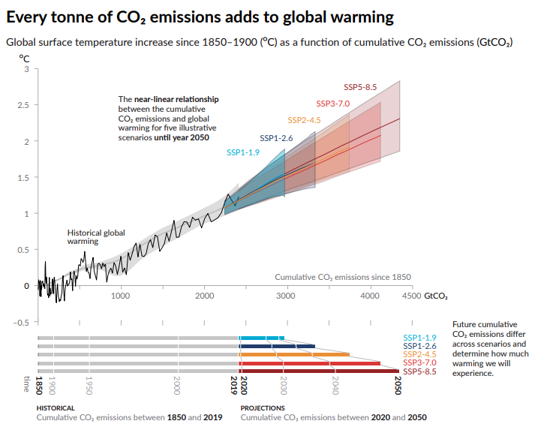
About Carbon
Carbon Emissions & Climate Change
After decades of debate, there is now strong scientific evidence and global consensus on the significant threat of climate change on human wellbeing and health of the planet.
Source: 2022, IPCC, five emissions scenarios were considered
-
Greenhouse gases (GHGs) warm the Earth by absorbing energy and slowing the rate the energy escapes, with different GHGs having different effects on warming. GHGs include Carbon Dioxide (CO2), Methane, and Nitrous Oxide.
-
C02 is the largest contributor to climate change as it most common. There is a near-linear relationship between cumulative CO2 emissions and global warming, with each 1000 GtCO2 of cumulative CO2 emissions to likely cause a 0.27°C to 0.63°C increase.
-
In 2021, the Glasgow Climate Pact was adopted. Almost 200 countries are now targeting to cut carbon emissions by 45% by 2030 and achieve net-zero emissions by 2050 in order to limit global warming to 1.5°C.
Voluntary Carbon Market
The ‘Voluntary Carbon Market’ is growing rapidly, facilitating the trading of carbon offsets independent of regulatory requirements.
-
Growth in demand is driven by the strengthening global focus on net-zero where individuals, corporations and governments are purchasing carbon credits to offset their carbon emissions due to social responsibility, and Environmental, Social, and Governance drivers .
-
Over one fifth of the world’s 2000 largest publicly listed corporations have pledged net-zero targets, with even more devising climate action plans due to shareholder, regulator and customer expectations.
-
Ecosystem Marketplace estimates that the amount of carbon offsets traded in the Voluntary Carbon Market in 2021 was valued at US$1billion, and McKinsey research for the Taskforce on Scaling Voluntary Carbon Markets has estimated demand for voluntary carbon offsets to grow by a factor 100 by 2050.
Carbon Offsets and Pricing
A carbon offset (also referred to as carbon credit) is a tradable unit in the Voluntary Carbon Market, representing one ton of GHG emission reductions or removals. All offset projects must create a measurable, trackable, permanent and independently verified reduction in GHG emissions that would not have occurred in the absence of the revenue generated from the offset. To ensure that emissions reductions or removals are real and “additional,” meaning they would not have been achieved without carbon finance, the vast majority of carbon offset projects use third-party verified standards to approve their carbon credits.
-
Carbon offsets can be generated through projects which are certified as having reduced or removed GHG emissions , these include:
1. Avoidance/Reduction projects e.g. forest conservation; and
2. Removal/Sequestration projects e.g. afforestation and reforestation -
Carbon offset prices are growing rapidly - the price of Nature based Global Emissions Offset™ (N-GEO), a benchmark for nature-based emissions offsets, grew over 300% in year to January 2022.



